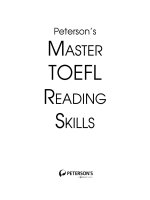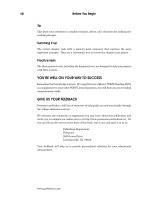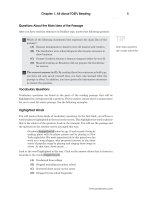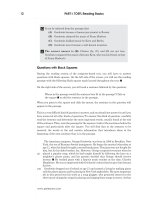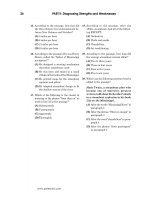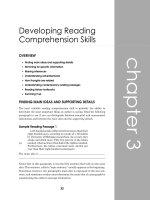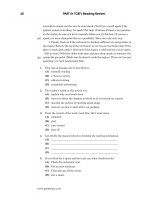Peterson’s master toefl writing skills part 25 pptx
Bạn đang xem bản rút gọn của tài liệu. Xem và tải ngay bản đầy đủ của tài liệu tại đây (64.46 KB, 7 trang )
CORRELATIVE CONJUNCTIONS
The following is a list of Correlative Conjunctions. Remember that they are always used in the
following pairs. Do not mix them up.
both and
either or
neither nor
notonly butalso
whether or
That music is both disturbing and loud.
Either he is going to get a job here or he is going to study in Los Angeles.
He is neither well qualified nor sufficiently experienced for that position.
He refused to say whether he would come to the meeting in person or send a
representative.
That horse is not only the youngest one in the race but also the only one to win two
years in a row.
a. Do not use both and for three or more nouns or adjectives.
Mary, Blair, and Margie are going to arrive late.
OR
Mary and Blair, as well as Margie, are going to arrive late.
b. Whether may sometimes be used alone.
I do not know whether she received the package.
Error Examples
WRONG: Both John, Ernest, and Paul are going to the game.
RIGHT: John and Ernest, as well as Paul, are going to the game.
OR
John, Ernest, and Paul are going to the game.
WRONG: That book includes only not records but also cassettes.
RIGHT: That book includes not only records but also cassettes.
WRONG: She won the dance competition because she had both originality as well as
grace.
RIGHT: She won the dance competition because she had both originality and grace.
WRONG: She decided not only to start a diet, but to join an exercise class also.
RIGHT: She decided not only to start a diet, but also to join an exercise class.
WRONG: That coin is not only valuable but rare also.
RIGHT: That coin is not only valuable but also rare.
Chapter 7: Style 157
www.petersons.com
WRONG: Neither the public or private sector of the economy will be seriously affected by
this new regulation.
RIGHT: Neither the public nor private sector of the economy will be seriously affected by
this new regulation.
WRONG: He refused to work either in Chicago nor in Detroit.
RIGHT: He refused to work either in Chicago or in Detroit.
Skill Builder 9: Correlative Conjunctions
Directions: Write a “C” on the line if the sentence is correct. Write an “X” on the line if
there is a correlative conjunction error.
1. Some students can neither write or speak accurately.
2. That course includes not only TOEFL preparation but also techniques of test
taking.
3. They like both living abroad as well as living at home.
4. Tom won not only the 100-yard dash but the broad jump also.
5. He is neither limber nor quick.
6. Either you will attend class regularly or you can expect a low grade.
7. Whether out of necessity or greed, he accepted the bribe.
8. Both the president and the vice-president gave speeches last night.
9. The play was both long, boring, and depressing.
10. He is both deceptive as well as irresponsible.
Answers
X
1. (neither write nor speak)
C
2.
X
3. (both living abroad and
living).
X
4. (not only the 100-yard dash,
but also the broad jump)
C
5.
C
6.
C
7.
C
8.
X
9. (was long, boring, and
depressing) OR (long and
boring, as well as depressing).
See note a.
X
10. (both deceptive and irrespon-
sible)
158 PART III: TOEFL Writing Review
www.petersons.com
SUBJECT/VERB AGREEMENT
Singular subjects take singular verbs. Plural subjects take plural verbs.
The secretary
S
in this office comes
VERB
to work at eight.
The secretaries
S
in this office come
VERB
to work at eight.
Problems in determining the subject:
1. Subjects are never found in prepositional phrases.
The price
S
of all these items
PREP. PHRASE
is
VERB
twenty dollars.
The characters
S
in this story
PREP. PHRASE
are
VERB
well developed.
2. Here and there are not subjects. Look after the verb to find the subject.
Here comes
VERB
the bus
S
.
There are
VERB
many good reasons
S
to study language.
3. The subject also follows the verb in this pattern:
On the door
ADV.
was
VERB
a wreath
S
of flowers.
Around the corner
ADV.
are
VERB
several small shops
S
.
4. Expressions introduced with words such as along with, besides, like, as well as, and
including do not change the number of the subject.
Mr. Jones
S.
, along with his wife and six children, is going
VERB
to Paris.
The weather
S
, as well as economic conditions, is
VERB
a consideration
Several candidates
S
, including John Baker, are going
VERB
.
5. When two subjects are joined by either or or neither nor, the subject closer to
the verb determines its number.
Neither Mary
S
nor her sisters
S
are going
VERB
to the party.
Either my sisters
S
or my mother
S
is going
VERB
to the wedding.
6. Some words look plural but are singular. Among these words are economics, mathemat-
ics, physics, news, and politics.
The news
S
was
VERB
good.
Mathematics
S
is
VERB
a challenging field.
Chapter 7: Style 159
www.petersons.com
7. The subject of a relative clause, who, which,orthat, is singular or plural depending on
its antecedent.
The students
ANTECEDENT
who
S
come
VERB
to class every day generally progress rapidly.
Bob is one of my friends
ANTECEDENT
who
S
are helping
VERB
me paint my house.
Bob is the only one
ANTECEDENT
of my friends who
S
is helping
VERB
me paint my house.
Error Examples
WRONG: His influence over the last ten years have grown considerably.
RIGHT: His influence over the last ten years has grown considerably.
WRONG: Over the fireplace hangs several small paintings.
RIGHT: Over the fireplace hang several small paintings.
WRONG: Neither the moon nor the stars is visible.
RIGHT: Neither the moon nor the stars are visible.
WRONG: A study of all possible causes of these multiple fractures are in order.
RIGHT: A study of all possible causes of these multiple fractures is in order.
WRONG: There occurs to me a few possible explanations for his behavior.
RIGHT: There occur to me a few possible explanations for his behavior.
WRONG: His furniture, including a dining room table and six chairs, are being sold.
RIGHT: His furniture, including a dining room table and six chairs, is being sold.
WRONG: I asked all the students who was willing to help to meet me at the school.
RIGHT: I asked all the students who were willing to help to meet me at the school.
WRONG: The college newspaper prints only the news that are of interest to the students
and faculty.
RIGHT: The college newspaper prints only the news that is of interest to the students
and faculty.
WRONG: Either the students or the teacher were mistaken.
RIGHT: Either the students or the teacher was mistaken.
160 PART III: TOEFL Writing Review
www.petersons.com
Skill Builder 10: Subject/Verb Agreement
Directions: Write a “C” on the line if the sentence is correct. Write an “X” on the line if
there is an error in subject-verb agreement.
1. There are several jobs available.
2. Along the beach was several small boats that had been washed ashore.
3. Neither my sisters nor my brother is ready to begin college.
4. The lack of logic in his arguments never cease to surprise me.
5. She was determined to study nuclear physics, which was the most difficult
course offered at that school.
6. Students who have difficulty with this subject should try to find someone who is
willing to tutor them.
7. Either her husband or her children is going to be upset no matter what decision
she makes.
8. Betty is one of the women who is responsible for writing that.
9. My uncle, as well as my father, are going to Canada on business.
10. The only one of his friends who is upset with John is Bob.
Answers
C
1.
X
2. (were several small boats).
See rule 3.
C
3.
X
4. (never ceases). See rule 1.
C
5.
C
6.
X
7. (or her children are going).
See rule 5.
X
8. (the women who are respon-
sible). See rule 7.
X
9. (is going). See rule 4.
C
10.
Chapter 7: Style 161
www.petersons.com
PARTS OF SPEECH*
Sometimes a word can be identified as a noun, adjective, adverb, or verb by its suffix (ending).
1. The following suffixes usually indicate nouns:
-ion, -sion, -tion population
-acy accuracy
-age image
-ance, -ence permanence
-hood childhood
-ar, -or scholar, doctor
-ism socialism
-ist artist
-ment government
-ness happiness
-y beauty
-ty reality, capacity
2. The following suffixes usually indicate adjectives:
-al natural
-ful beautiful
-ly friendly
-ic chronic
-ish childish
-like childlike
-ous populous, numerous
-y happy
-ate accurate
-able, -ible capable, terrible
3. The following suffix usually indicates adverbs:
-ly happily, readily, beautifully
4. The following suffixes usually indicate verbs:
-ify beautify
-ate populate
-ize realize
* See also Chapter 3, “Modifiers”—Adjective/Adverb Confusion, page 32.
162 PART III: TOEFL Writing Review
NOTE
There are some
exceptions to
these general
rules.
www.petersons.com
Error Examples
WRONG: I was amazed at her natural beautiful.
RIGHT: I was amazed at her natural beauty.
WRONG: His illness was chronically.
RIGHT: His illness was chronic.
WRONG: Happily is a rare state of being.
RIGHT: Happiness is a rare state of being.
WRONG: He had an unhappy childlike.
RIGHT: He had an unhappy childhood.
WRONG: You should reality the truth.
RIGHT: You should realize the truth.
WRONG: That country has a very large populate.
RIGHT: That country has a very large population.
Skill Builder 11: Parts of Speech
Directions: Write a “C” on the line if the sentence is correct. Write an “X” on the line if
there is an error in the part of speech according to the suffix.
1. Bob hopes to beauty his home by painting and carpeting.
2. Lawrence is a very happily man.
3. Japan is a very populous nation.
4. What do you think is the real of that situation?
5. Her manner was friendly and natural.
6. Dr. Smith’s capacity for hard work was incredible.
7. I never questioned his accurately.
8. Jane was surprised that he spoke so childish.
9. That new medicine will not be readily available until next year.
10. Does the book list the populous of that country in 1950?
Answers
X
1. (Bob hopes to beautify). See
rule 4.
X
2. (a very happy man). See rule 2.
C
3.
X
4. (the reality of that situation).
See rule 1.
C
5.
C
6.
X
7. (his accuracy). See rule 1.
X
8. (so childishly). See rule 3.
C
9.
X
10. (the population). See rule 1.
Chapter 7: Style 163
www.petersons.com

